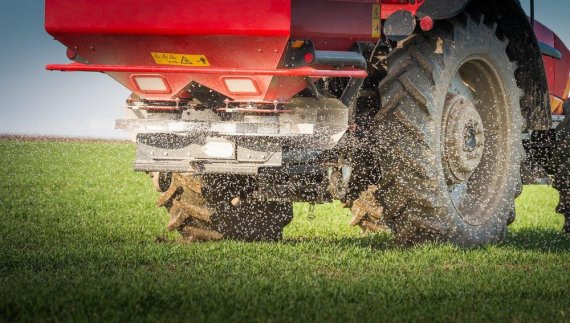Can we do without chemical fertilizers? © Shutterstock
Dutch agriculture annually emits approximately 26 megatons of CO2. The Cabinet wants agriculture to reduce these emissions by 3.5 megatons by 2030 using smart land use, decreased methane emissions in livestock farming and diminished gas use in horticulture.
Martin Scholten, director of the Animal Sciences group, thinks that this could be doubled – meaning a decrease of 7 megatons. ‘But we won’t get there with independent measures; we will need to change the entire agricultural system.’
Scholten speaks on behalf of a group of Wageningen researchers who have spent the past year exploring the possibilities of a climate-smart agriculture. ‘We want to actively investigate how we could apply the plans of the Cabinet’, Scholten says.
Which concrete measures would be useful?
‘In the first place, we look at mitigation, that is decreasing the emissions of greenhouse gases. This approach stands on three pillars. First: we make the horticultural greenhouses more energy efficient and make a larger-scale switch from gas to solar and geothermal heat. In time, this should yield a decrease of 1 megaton of CO2. Second: we reduce the methane emissions by cattle at livestock farms. This could be achieved by breeding cattle that produces les methane and by a better storage and use of fertilizer. This could save 1.5 megaton of CO2. And third: climate-smart land use, in which we capture more carbon and nitrogen in the soil and strengthen the soil’s content of dead organic material. This would yield a maximum of 2 megatons of CO2.’
The system challenge is to keep carbon and nitrogen trapped in a circular food system.
Martin Scholten, director Animal Sciences Group
‘These are the classic mitigation measures, but we want more. We should reassess the entire agricultural system and determine whether a system change could lead to climatic gain. Take chemical fertilizers, for example: could we do without those in the Netherlands in order to remove the greenhouse gas emissions from chemical fertilizers? Crop farmers could stop ploughing – a source of emissions – and reuse crop remains as cattle feed more often, thus creating circular agriculture. The system challenge is to keep carbon and nitrogen trapped in a circular food system, thereby minimising climate effects.’
And the soil would be at the focus of this, like in organic agriculture?
‘The soil, or more precisely a good soil management, is key to achieve this.’
Does this mean soil-bound agriculture?
‘Not in the classical sense if you mean: farmers are allowed an x number of cattle per hectare. I wouldn’t want to handle this at the company level but would rather argue for a new approach in which we integrate crop farming and cattle farming and look at the healthy utilisation of fertilizers on the limited land in the Netherlands. New coalitions of crop farmers and cattle farmers are needed that would deal with fertilizers and crop remains responsibly.’
Who should organise these coalitions?
‘The farmers can’t do that by themselves; agribusiness and retailers would also need to have an active role in this. I saw a great example last week. Sugar producer Cosun wants to make the beet leaves suitable for cattle feed. Those are the steps we need to take. That is how you utilise food remains, how you decrease import of cattle feed and how you create a circular food system.’
We import about 70 percent of our food, while we export 70 percent of [our] production.
Martin Scholten, director Animal Sciences Group
We could also reduce the cattle population, as proposed last week by the Council for the Environment and Infrastructure (RLI).
‘That is a meagre answer to the problems, as we would be left with a smaller, climate-unhealthy agriculture in the Netherlands. And we would keep importing and exporting food that is less sustainable. Did you know that we import about 70 percent of our food, while we export 70 percent of Dutch food production? There must be a climate-smarter way to do this. A decrease of the cattle population is not a structural solution. But it could be the result of climate-smart circular agriculture.’
What should the farmers do and avoid doing?
‘In the current situation, there are farmers that maximise their gains using top materials, but also waste a lot of resources and produce a lot of waste in the process. Those farmers should adjust their management to limit their losses. They should want to avoid residual waste flows, use compost instead of chemical fertilizers, cherish the soil’s fertility, plough as little as possible and procure robust cattle with low methane emissions. Furthermore, they should organise a circular agriculture together with suppliers and customers. That is a system change. To reap results later, we must start working on it now.’
Additional reading (partly in Dutch):
Case for radical change in agriculture sector
Wat betekent het klimaatbeleid van dit kabinet?

